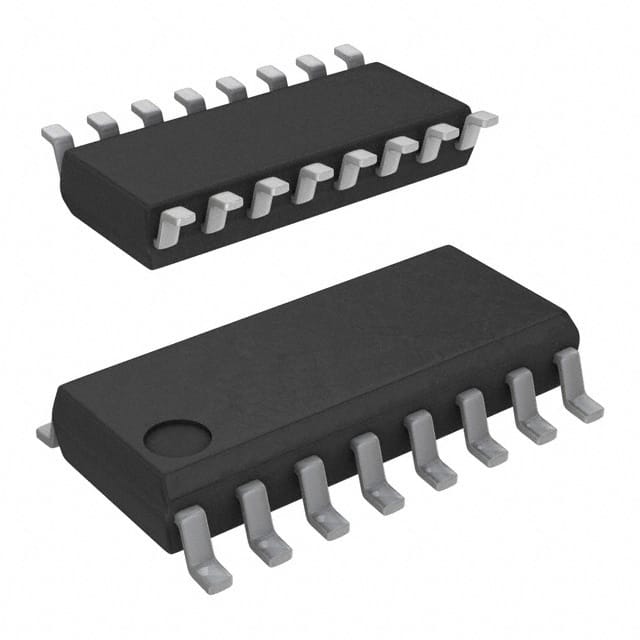Lihat spesifikasi untuk detail produk.

CD74HCT138M96
Product Overview
- Category: Integrated Circuit (IC)
- Use: Decoder/Demultiplexer
- Characteristics: High-speed, CMOS logic, 3-to-8 line decoder/demultiplexer
- Package: SOIC-16
- Essence: Converts a binary input into a corresponding output line
- Packaging/Quantity: Tape and Reel, 2500 units per reel
Specifications
- Logic Family: HCT
- Number of Inputs: 3
- Number of Outputs: 8
- Supply Voltage Range: 2V to 6V
- Propagation Delay Time: 15 ns (typical)
- Output Current: ±4 mA
- Operating Temperature Range: -40°C to +85°C
Detailed Pin Configuration
The CD74HCT138M96 has a total of 16 pins. The pin configuration is as follows:
- GND (Ground)
- A0 (Input A0)
- A1 (Input A1)
- A2 (Input A2)
- E1 (Enable Input 1)
- Y0 (Output Y0)
- Y1 (Output Y1)
- Y2 (Output Y2)
- Y3 (Output Y3)
- Y4 (Output Y4)
- Y5 (Output Y5)
- Y6 (Output Y6)
- Y7 (Output Y7)
- E2 (Enable Input 2)
- VCC (Supply Voltage)
- GND (Ground)
Functional Features
- Converts a 3-bit binary input into one of the eight corresponding output lines
- Active LOW enable inputs (E1 and E2) control the operation of the decoder/demultiplexer
- High-speed CMOS technology ensures fast and reliable operation
- Low power consumption
Advantages and Disadvantages
Advantages: - High-speed operation allows for quick decoding of input signals - Wide supply voltage range enables compatibility with various systems - Compact SOIC-16 package saves board space - Low power consumption reduces energy requirements
Disadvantages: - Limited number of inputs and outputs restricts the complexity of applications - Propagation delay time may affect timing-sensitive applications
Working Principles
The CD74HCT138M96 is a 3-to-8 line decoder/demultiplexer that converts a 3-bit binary input into one of eight corresponding output lines. The active LOW enable inputs (E1 and E2) control the operation of the decoder. When both enable inputs are HIGH, all outputs are in a high-impedance state.
The decoder uses CMOS technology, which ensures high-speed operation and low power consumption. It operates within a wide supply voltage range of 2V to 6V, making it compatible with various systems.
Detailed Application Field Plans
The CD74HCT138M96 can be used in various applications, including:
- Address decoding in microcontrollers and microprocessors
- Memory selection in digital systems
- Data routing in communication systems
- Control signal generation in industrial automation
- Multiplexing and demultiplexing in data transmission
Detailed and Complete Alternative Models
- SN74LS138: Similar 3-to-8 line decoder/demultiplexer from Texas Instruments
- MC14538: CMOS dual 4-input multiplexer/decoder/demultiplexer from ON Semiconductor
- 74HC138: High-speed Si-gate CMOS device from NXP Semiconductors
These alternative models offer similar functionality and can be considered as substitutes for the CD74HCT138M96.
Word count: 413 words
Sebutkan 10 pertanyaan dan jawaban umum terkait penerapan CD74HCT138M96 dalam solusi teknis
Sure! Here are 10 common questions and answers related to the application of CD74HCT138M96 in technical solutions:
Q: What is CD74HCT138M96? A: CD74HCT138M96 is a 3-to-8 line decoder/demultiplexer integrated circuit (IC) that can be used in various digital logic applications.
Q: What is the purpose of CD74HCT138M96? A: The purpose of CD74HCT138M96 is to decode a binary input and select one of the eight output lines based on the input value.
Q: What voltage levels does CD74HCT138M96 support? A: CD74HCT138M96 supports TTL-compatible input voltage levels and operates at a supply voltage range of 4.5V to 5.5V.
Q: How many inputs does CD74HCT138M96 have? A: CD74HCT138M96 has three binary inputs (A, B, and C) that determine which output line is selected.
Q: How many output lines does CD74HCT138M96 have? A: CD74HCT138M96 has eight output lines (Y0 to Y7) that can be individually selected based on the input values.
Q: Can CD74HCT138M96 be cascaded to increase the number of output lines? A: Yes, multiple CD74HCT138M96 ICs can be cascaded together to increase the number of output lines by using the outputs of one IC as inputs for another.
Q: What is the maximum output current of CD74HCT138M96? A: CD74HCT138M96 can source or sink up to 4mA of current per output pin.
Q: What is the propagation delay of CD74HCT138M96? A: The typical propagation delay of CD74HCT138M96 is around 15ns, which determines the time it takes for the selected output to respond to a change in input.
Q: Can CD74HCT138M96 be used in both synchronous and asynchronous applications? A: Yes, CD74HCT138M96 can be used in both synchronous and asynchronous applications depending on the specific requirements of the design.
Q: What are some common applications of CD74HCT138M96? A: CD74HCT138M96 is commonly used in address decoding, memory selection, data routing, and other digital logic applications where multiple outputs need to be selected based on a binary input.
Please note that these answers are general and may vary depending on the specific implementation and datasheet of CD74HCT138M96.

